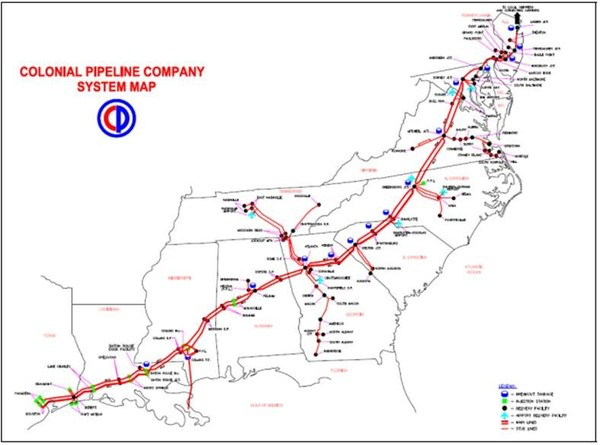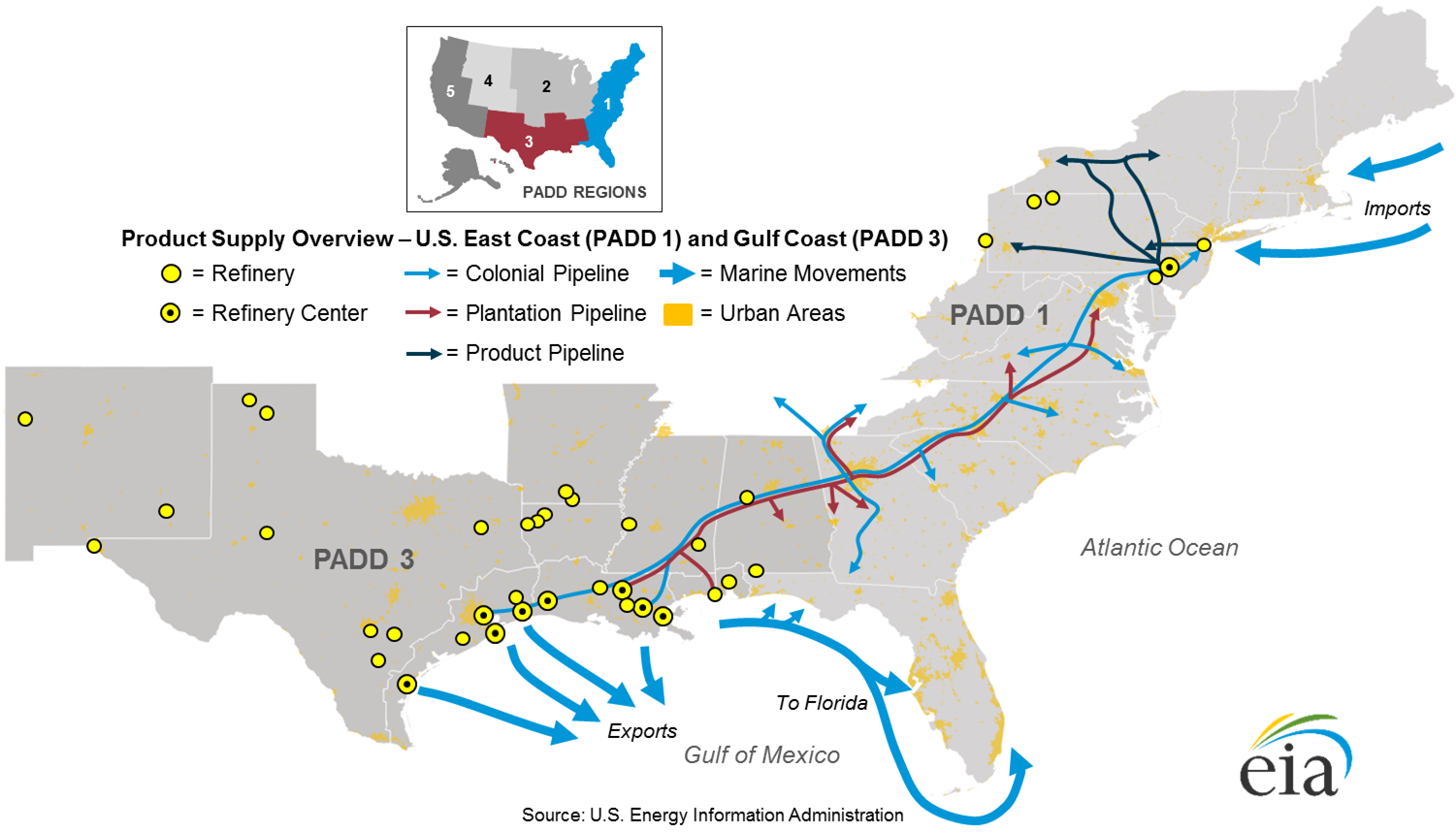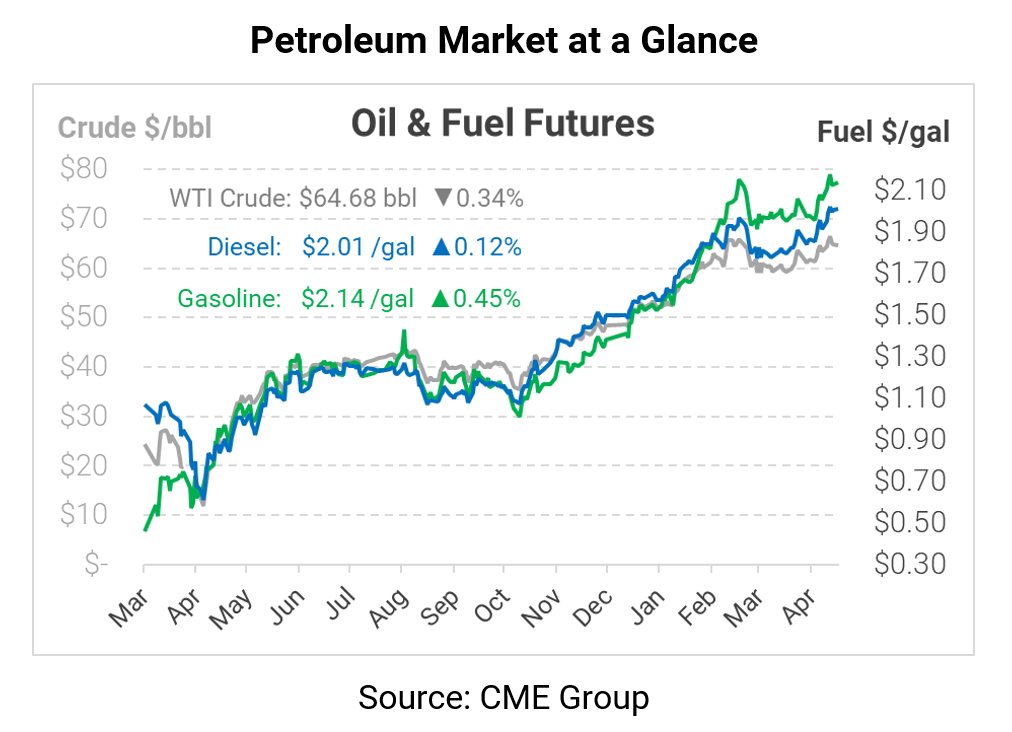Colonial Pipeline Hit by Cyberattack – Detailed Report
The Colonial Pipeline, which supplies fuel to markets throughout the East Coast, reported on Friday, May 7 that it experienced a “network outage” requiring it to shut down operations. Over the weekend, the company confirmed that the outage was the result of a cyberattack, which investigators say stemmed from a rogue group of hackers known as DarkSide. Colonial has reportedly engaged the cybersecurity company FireEye to respond to the threat.
Today’s FUELSNews report will take a deep dive into what the Colonial Pipeline is, why it matters, and how this outage will impact fuel supplies and prices.
What Is the Colonial Pipeline?
The Colonial Pipeline runs from Houston, TX up to Linden, NJ, supplying 2.5 million barrels per day of gasoline, diesel, heating oil, and jet fuel. The pipeline makes up roughly 50% of fuel supplies to the East Coast. The pipeline also operates numerous spur lines, which send fuel to Tennessee, southern Georgia, eastern North Carolina, and other areas further from the main pipeline.
How Does the Colonial Pipeline Operate
The Colonial Pipeline operates in five-day cycles, meaning markets are used to being restocked every five days or so. Markets scheduled to receive fuel over the weekend will be the tightest, while other markets have been able to go longer without fuel. The longer the outage lasts, though, the more severe the shortage may be.
Once the network outage is resolved, refilling inventories will be the next challenge. Fuel moves at a rate of 3-5 mph through the pipeline, so it takes 10-14 days to ship fuel from Houston to New York. Even after pipeline operations resume, it will take weeks to bring markets back to full operations.
What Happens During a Cyberattack?
When a cyberattack is detected, companies typically shut down both infected and non-infected systems to limit the spread of the damage. Once the threat is neutralized (by paying the ransom or eliminating the malware), it can still take time to bring systems back online. IT teams must go through each system to look for damage or lingering malware.
The Colonial Pipeline Company was hit by a ransomware attack, which involves hackers shutting down major systems or locking down critical data. They then extort the owner to pay anywhere from hundreds of dollars to multi-millions of dollars to resume system operations.
Investigators believe the group DarkSide is behind the attack. That group reportedly uses a “double extortion” approach, locking down data and threatening to make it public if the ransom is not paid.
How Long Could This Last?
So far, the Colonial Pipeline Company has given no indications of how long this event may last. It could be resolved in hours, days, or weeks. The length of the outage will be critical in determining how severe the impact is:
- Short Outage: If the pipeline is offline less than five days (ie, a resolution before 5/11), markets could bounce back relatively quickly. Suppliers would be able to reopen their allocations and allow normal purchases, since a pipeline shipment would be forthcoming.
- Intermediate Outage: If the pipeline is operational before next Monday, the impact will likely be short-term outages along the pipeline. Refiners may need to limit their output, and crude inventories might rise a bit.
- Long Outage: A prolonged outage, extending over ten days, could severely disrupt Gulf Coast refining operations, causing major builds in PADD 3 crude inventories and severe shortages of fuel along the East Coast. Barge shipments from other countries would begin flowing to NY Harbor, but transporting that fuel throughout the Gulf Coast would be a challenge. Given the on-going carrier shortage, the result would be further constrained markets and major logistics challenges.
Are There Other Ways to Supply the East Coast?
The Colonial Pipeline provides roughly half the fuel consumed along the East Cost. The rest comes from a variety of sources:
- Other pipelines may provide some help. The Plantation Pipeline runs a similar route, traversing from Gulf refiners up to Washington DC. However, it carries only a quarter as much fuel, supplying 720 kbpd. The Plantation is an existing pipeline, so its ability to scale up to fill the gap is limited. Besides the Colonial and Plantation, the only other pipeline supplying the East Coast is the Laurel Pipeline, which transports from the Chicago region to Pennsylvania.
- Barge deliveries are possible for different areas. Gulf Coast refiners may use barges to haul fuel to coastal markets such as Savannah and Charleston, though this method is slow and pricier than pipeline deliveries. European refiners can ship more fuel across the Atlantic to New York Harbor, though these deliveries take as long as two weeks. The situation would have to extend for weeks for European imports to catch up.
- Long-hauled fuel from surrounding regions will be the most important emergency measure for fuel. Whether it’s trucking fuel from Ohio and other unconstrained markets eastward, or hauling product from coastal markets inland, truck deliveries will be a critical logistics option to meet demand.
How Are Governments Responding?
The Federal Motor Carrier Safety Administration has declared an emergency for states ranging from Texas to New York. The emergency waives hours of service requirements, allowing drivers to work longer to deliver fuel.
From a supply standpoint, the federal government is evaluating releasing supplies from the Northeast Gasoline Supply Reserve. The reserve of one million gasoline barrels held in New York, Boston, and Maine would only be a temporary solution, but it might help mitigate higher prices in some northern markets.
How Will This Impact Fuel Prices?
Fuel prices will see different impacts in different areas. Texas, which supplies the pipeline, may see prices fall as inventories rise. For markets along the Colonial Pipeline’s path, expect to see prices rise as local supplies dry up. Higher prices can stem both from higher supply costs and from higher freight rates, given driver shortages and logistics constraints.
NYMEX prices, which are based on NY Harbor rates and set the tone for national fuel prices, could be particularly impacted. The Colonial Pipeline transports fuel to New Jersey, so it’s an important supply source for NY consumers. As northeast prices rise, NYMEX Futures will also get a lift. That could affect consumers around the country since many fuel indexes are pegged to the NYMEX. Gasoline prices rocketed to $2.20 in Monday early morning trading, though so they have since fallen lower.
Before the cyberattack occurred, the Colonial Pipeline had not been running at full capacity since fuel demand was down. Diesel demand tends to be a bit lower in May, which will help prevent shortages. Gasoline demand, on the other hand, is ramping up ahead of summer driving season. Analysts had expected gasoline prices to peak ahead of Memorial Day, but now expect prices to peak much sooner.
This article is part of Alerts
Tagged: Colonial Pipeline, Cyberattack, Pipeline Outage, supply alert
MARKET CONDITION REPORT - DISCLAIMER
The information contained herein is derived from sources believed to be reliable; however, this information is not guaranteed as to its accuracy or completeness. Furthermore, no responsibility is assumed for use of this material and no express or implied warranties or guarantees are made. This material and any view or comment expressed herein are provided for informational purposes only and should not be construed in any way as an inducement or recommendation to buy or sell products, commodity futures or options contracts.








